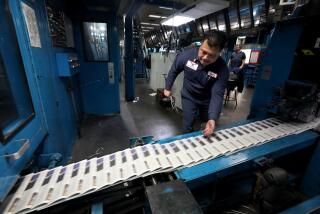On your dayâs to-do list, is reading the paper a must?
If you think about the 10 or 15 things you absolutely have to do today, and the various decisions you have to make about them, how helpful would you say your daily newspaper is likely to be in any of those endeavors? My guess is youâd say, âNot veryâ -- no matter what paper you read.
âWe have become disturbingly disconnected from average Americans,â says Martin Baron, editor of the Boston Globe, âfrom their most basic concerns about getting by day to day, paying the bills, educating the kids, holding together marriages, making it through work.â
In large part, thatâs because journalists define news as a departure from the norm -- something new, different, sensational, spectacular, terrible, tragic, triumphant, scandalous -- and they havenât figured out how to stretch that definition to include the everyday. But the norm (driving through traffic, interacting with office colleagues, disciplining children) defines many peopleâs daily lives.
That doesnât mean newspapers should ape the news-you-can-use approach of local television news. Most people buy a daily newspaper because theyâre interested in whatâs happening in the world at large -- especially when, as now, much of whatâs happening is confusing, even frightening. People want help making sense of the dayâs events.
So how can newspapers be relevant on routine, personal issues -- while simultaneously trying to explain terrorism, global warming and a faltering economy? There is room in a good newspaper for both functions, and the best way to balance them is to connect them.
Connecting the personal to the political and the global to the local is a matter of survival for newspapers, which have been losing circulation for more than 30 years. Knowing that they risk becoming irrelevant to readers who are busier than ever, and who have ever more alternative sources of information, many newspapers across the country are trying desperately to make those connections.
Workplace coverage
Some newspapers used to have full-time âlabor reportersâ who devoted much of their time to covering internal union politics. Now several papers cover the less contentious but, to many, more relevant issues of the workplace -- and in the process, connect the impersonal, at times mind-numbing statistics of the business section with the realities of everyday employment. The Boston Globe, for example, has a weekly âBostonWorksâ feature that provides coverage of such workplace issues as health care, finding a new job, mid-career education and techniques for creating a positive work environment.
Other papers have tried to make a different connection -- between reader and community -- by providing the kind of neighborhood news and information once limited to small weekly newspapers. The Dallas Morning News has created a series of 13 localized regional zone sections that offer a list of new books in the public library; the addresses and prices of recent home sales; meeting times and places for social, civic and service clubs; and greens fees at local golf courses.
The Los Angeles Times, in redesigning all its feature sections, tried -- among other objectives -- to make them more useful to readers. It shifted many of its entertainment listings from Sunday Calendar to the Calendar section published on Thursdays, for example, figuring that would be advantageous to readers planning their weekend activities (although many readers actually complained about the change).
A growing number of newspapers -- the Orange County Register, Detroit Free Press, Seattle Times and San Francisco Chronicle among them -- are publishing weekly guides to local road construction, detours, blockages and mass transit issues.
âWe have âCommuter Chroniclesâ every Monday, but we still donât do enough with it,â says Phil Bronstein, executive editor of the Chronicle. âWe need to have reporters actually travel the problem routes and explain how you can avoid the traffic jams, provide alternate routes. This is useful, practical information about real-life, real-time experiences.â
But newspapers shouldnât sacrifice their uniqueness on the altar of usefulness. They canât surrender their role as public watchdog nor their functions of analysis and explanation to make room for ârelevantâ stories of dubious value. Papers can misfire badly when their quest for relevance leads them to superficial âhow toâ stories or misguided attempts to connect with readers by giving disproportionate attention to catchy subjects.
One day recently, just when the congressional debate on Iraq was ratcheting up, USA Today devoted its biggest Page 1 headline to a new study on obesity in America -- and relegated Iraq to Page 10.
Too often these days, some newspapers seem to be allowing their advertising departments, rather than their editors, to decide whatâs ârelevant.â New features are introduced with the announced intent of âserving readersâ and âconnecting to readersâ when their real purpose often seems to be to lure lucrative advertising dollars.
âMany papers that have tried to be relevant have mistakenly interpreted ârelevanceâ as only what happens within a 20-square-mile radius of the office or as something very practical and direct -- where to buy a pillow, how to lose 20 pounds in the next two weeks or what to cook for dinner tonight,â says Sandra Mims Rowe, the editor of the Portland Oregonian.
âThose are all relevant to peopleâs lives, but relevance and what is useful also has a much broader definition and involves more complexity and depth and understanding,â she says.
Rowe and the Oregonian have been ambitious. Three years ago, the paper won a Pulitzer Prize for reporter Richard Readâs pursuit of a single lot of potatoes from a processing plant in Oregon back to the growers and then on to Singapore, where it went to a McDonaldâs. The Pulitzer board praised Read for âvividly illustrating the domestic impact of the Asian economic crisis,â and Rowe says his account âcouldnât have been any more relevant, any more important, to our readers.â
Other newspapers have to be similarly creative -- and similarly ambitious -- in finding and reporting stories that show their readers how, and why, important social, political and economic issues can affect them and their families.
Fourteen months ago, most Americans probably didnât think a small fundamentalist Islamic sect in the remote mountains of Afghanistan was terribly relevant to their lives. Judging from the decline in international reporting through the late 1980s and early 1990s, most newspaper editors and television news directors didnât think so either.
Everyone learned differently on Sept. 11.
*
David Shaw can be reached at [email protected]
More to Read
Sign up for Essential California
The most important California stories and recommendations in your inbox every morning.
You may occasionally receive promotional content from the Los Angeles Times.










